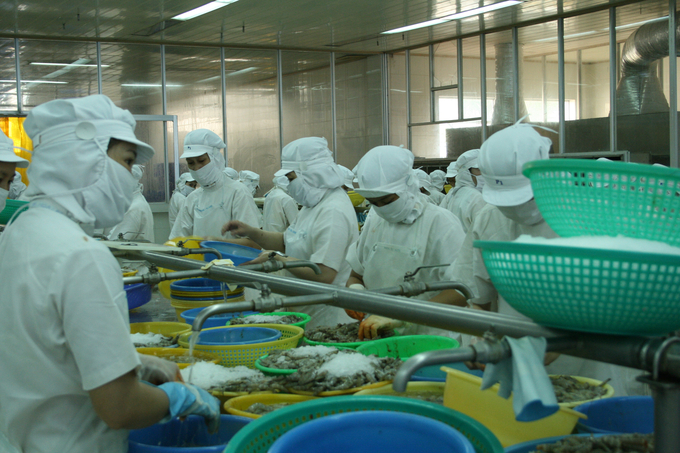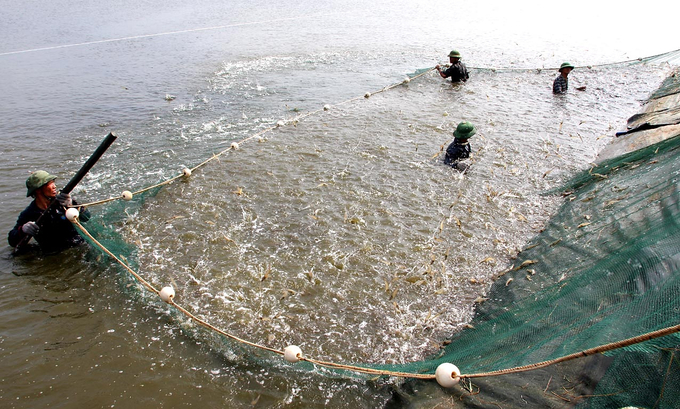May 30, 2025 | 04:03 GMT +7
May 30, 2025 | 04:03 GMT +7
Hotline: 0913.378.918
May 30, 2025 | 04:03 GMT +7
Hotline: 0913.378.918

According to the Ministry of Agriculture and Rural Development (MARD), Vietnam’s fisheries export value in the first six months of 2023 is estimated at VND 4.13 billion, down 27.4% compared to the same period in 2022. Photo: Hong Tham.
Vietnam’s fisheries industry implements its production and development plan for 2023 in a mix of advantages and challenges, in which the export market is struggling the most.
Fisheries output in the first six months of the year is approximately 4.27 million tons, reaching 47.2% of the plan, and aquaculture in particular achieves more than 2.336 million tons. Fisheries export value is estimated at USD 4.13 billion, down 27.4% over the same period in 2022. Brackish water shrimp reaches USD 1.56 billion, down 36.6% over the same period, pangasius reaches USD 885.5 million, down 38%.
Fisheries exports in May and June show much better results than the first months, signaling that the export market is starting to improve and is likely to recover in the third and fourth quarters of the year. Yet current product prices remain low and profits are not much, so farmers have this mindset of "anchoring the ponds" and waiting for signals from the market, which reveals certain risks. In the last months of 2023, the industry may lack inputs to serve processing and export, thus affecting the growth target.
In order to secure stable development for aquaculture in the last months of 2023, thus meeting the demand for aquatic inputs in terms of both quantity and quality, the Ministry of Agriculture and Rural Development requests the People's Committees of provinces and cities under Central to urgently organize and implement a number of key tasks:
1. Organize forces to grasp, review, synthesize and compile statistics on the input sources, quantity and production capacity in service of aquaculture; the amount of aquatic products currently raised; the amount of seafood currently available at processing and export facilities; the price developments of aquatic inputs. Timely inform enterprises and farmers to have specific and appropriate plans and solutions in farming, processing and exporting.
2. Stabilize the farming of key aquatic species and promote the development of marine farming while taking species with high economic value into consideration; maintain the area of ecological and organic models (shrimp - rice, shrimp - forest, etc.) as well as the improved extensive farming models; combine measures to increase productivity and output; promote the advantages of black tiger prawn products; develop white-legged shrimp farming in areas with sufficient infrastructure and good control over production stages.
3. Focus on developing the pangasius production chain from breeds, feed to commercial farming. Develop offshore aquaculture with species that can give large yields (Asian seabass, golden pompano, cobia, etc.) associated with creating livelihoods for farmers and protecting the coastal environment. Develop farming of endemic species with local economic value.
4. Implement solutions to reduce costs in aquaculture. Apply advanced techniques at all stages of the farming process to increase survival rate and reduce feed conversion ratio (FCR). Organize production linkage to reduce intermediaries and make sure that farmers can get access to input (seeds, feed, aquaculture environmental treatment products, etc.) in the fastest manner at the lowest cost.
5. Strengthen environmental monitoring in concentrated aquaculture areas; promptly issue recommendations and warnings to farmers; perform disease prevention and control well to minimize damage in the production process.

It is necessary to implement solutions to reduce costs in aquaculture. Photo: Van Vu.
6. Implement food safety management and traceability in aquaculture; guide, appraise and issue food safety certificates according to the provisions of Circular 38/2018/TT-BNNPTNT dated December 25, 2018; confirm the registration of cage aquaculture and main products as prescribed in Decree 26/2019/ND-CP dated March 8, 2019 for aquaculture establishments; ensure aquatic products meet market requirements.
7. Develop aquaculture in the principle of cooperation with farmers as the center factor, establish connections between leaders at all levels, research units, business communities, and farmer’s unions to create added value in each production stage. Come up with solutions to support businesses, cooperatives, cooperative groups and farmers to optimize production link chains, reduce costs, improve efficiency, and promote domestic consumption and export.
8. Disseminate information, provide guidance and implement regulations of the 2017 Law on Fisheries, Decree 26/2019/ND-CP dated March 8, 2019, and related guiding documents in aquaculture; pay special attention to directing, removing difficulties and simplifying administrative procedures for registration of cage aquaculture.
9. Inspect and monitor the implementation of legal regulations in aquaculture specifically the management of seeds and farming process; strictly handle violations and publicize the results according to regulations.
Translated by Samuel Pham
/2025/05/25/4127-3-073637_820.jpg)
(VAN) Thanks to the promotion from an FAO-implemented project, vegetable production in greenhouses in Moc Chau has seen strong development, from 1.5 hectares in 2021 to nearly 50 hectares in 2024.

(VAN) FAO has recently supported USD 140,000 to implement the project 'Risk mitigation human-animal interface risks through disease control initiatives in pig farming.'

(VAN) The People's Committee of Tra Vinh province has approved an adjustment to the investment policy for the Green Hydrogen Plant project, increasing its area to approximately 52.76 hectares.
![Reducing emissions from rice fields: [2] Farmers’ commitment to the soil](https://t.ex-cdn.com/nongnghiepmoitruong.vn/608w/files/news/2025/05/05/dsc08881jpg-nongnghiep-140632.jpg)
(VAN) Clean rice cultivation model in Thuong Tan commune, Bac Tan Uyen district, is assisting local residents in achieving sustainable agriculture by substantially reducing costs, increasing productivity, and protecting the environment.

(VAN) At the conference to disseminate Resolution No. 68, AgriS introduced its digital agricultural ecosystem and reaffirmed its commitment to accompanying the Government in promoting private sector development and sustainable agriculture.

(VAN) 'Blue Ocean - Blue Foods' initiative is designed to restore marine ecosystems and establish sustainable livelihoods for local communities by cultivating a minimum of 1,000 hectares of cottonii seaweed in the first three years.
/2025/05/21/4642-3-112707_603.jpg)
(VAN) The V-SCOPE project has made direct contributions to three out of six pillars of the Comprehensive Strategic Partnership between Vietnam and Australia.